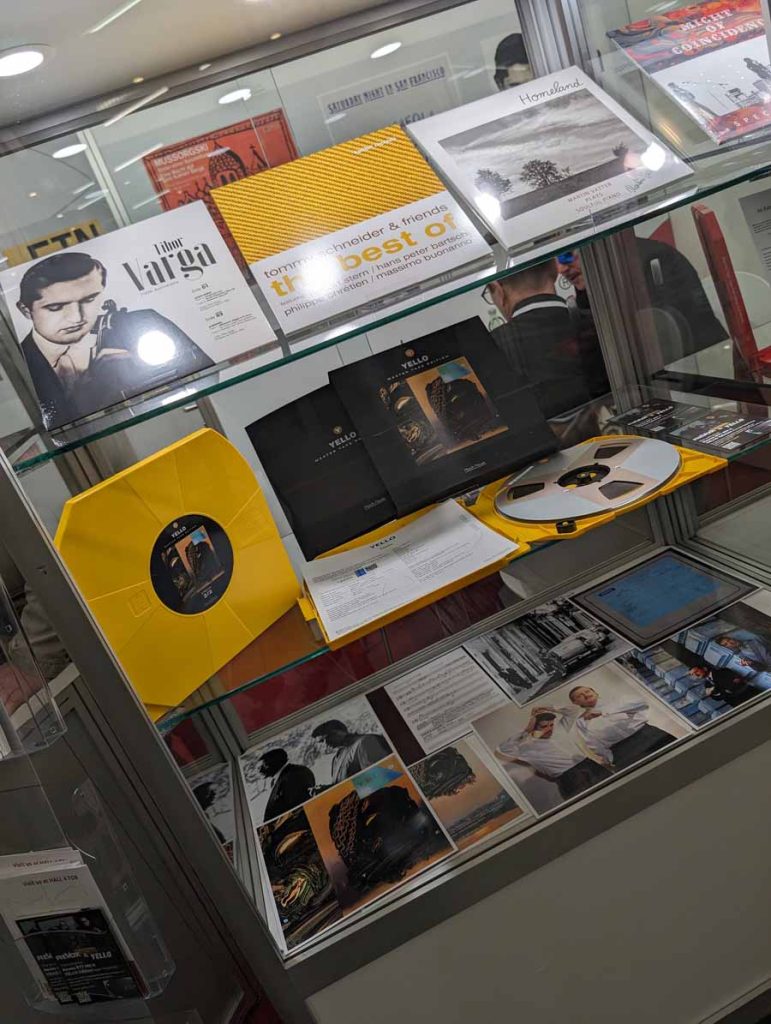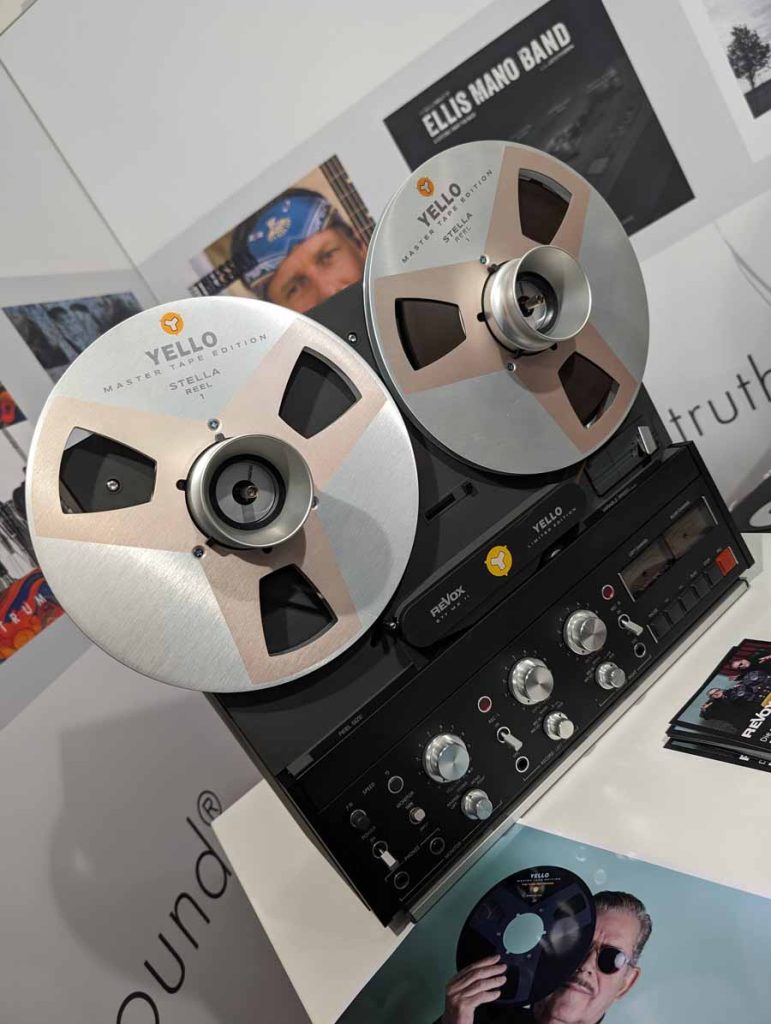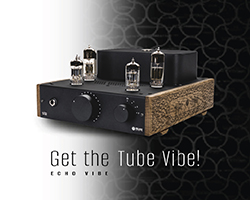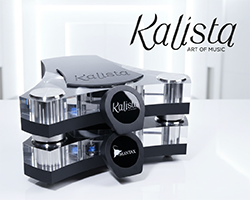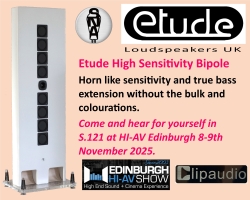YELLO STELLA 15IPS STUDIO MASTER COPY EDITION REVIEW & CHAT WITH BORIS BLANK
Alan McIntosh takes a listen to the 15ips Studio Master Copy of Stella by Yello and released on Horch House, whilst Stuart Smith has a chat with Boris Blank at High End Munich 2024.
ALL IMAGES AND TEXT ARE COPYRIGHT HiFi PiG AND MAY NOT BE USED WITHOUT PRIOR WRITTEN CONSENT FROM THE EDITOR
YELLO STELLA 15IPS STUDIO MASTER COPY EDITION REVIEW
Some reviews are harder than others. Why harder? Well, depending on what you have in for review there can be much more listening and conjugation time required. A/B’ing over time, being very sure of your observations, trying various combinations of connected components, or response to different types of music. Sometimes the nature of the product being reviewed has additional dimensions to consider – ones that can be very subtle, can lead to controversy or claims of pseudo-science – in the main digital or cable-related reviews or accessories. These quite correctly require lengthy (usually many weeks) of listening and technical research, plus fact-checking to make sure of certain specifications to be sure you have your review just right. It’s not a chore by any stretch and I love nothing more than a deep dive into a review – but they take effort.



Then there are easier reviews. What makes a review easy you ask? Well, let’s do a checklist.
Single component – check. Single format – check. Analogue (no digital naysayers to worry on) – check. High-quality materials – check. High-quality sound quality – check. Just a sit back and hit Play – check. Something you just enjoy listening to and where the sonic characteristics are abundantly clear– check and check! These reviews still require listening, research and considered opinions but they sure are more fun!
Check!
It will probably come as no surprise then, dear reader, that when I received my copy of Yello’s Stella on 15ips , 2 track Studio Master Copy tape from Horch House… it was always going to be an easier review for me.
For the reel-to-reel fan, right now feels like a golden era where we are seeing some incredible releases across Jazz (see my previous Blue Train, Sketches of Spain or Kind of Blue reviews) and classical (with the likes of Scheherazade from Mike Valentines Chasing the Dragon label) but what has really set my fires alight is the recent announcement that Yello, those masters of 80’s electronica/punk pop, are releasing 5 albums on tape across 2024 and 2025. The first – already loaded here at Mcintosh Towers is the sonic landmark album – Stella.


For anyone newer to the audiophile music world or who’s possibly been locked in a Truman Show-style alternate world, Yello are the pioneering Swiss duo of Boris Blank and Dieter Meier. Dieter joined Yello as frontman and vocalist in 1983 after the original pair of Boris and Carlos Perón (who left in late 83 to pursue a solo career) realised they were only going to get so far without a lead vocalist. Enter Meier – singer, conceptual artist, global entrepreneur, and one-time professional gambler (that and he played in the Swiss national Golf Team – I kid you not!). Blank could then focus on writing, sound, programming, music, and production. The two together formed a unique powerhouse of 80’s music – a partnership that has continued for decades – Toy was released in 2020 and Boris continues to produce superb works to this day. The third track on Stella and one that Dieter voiced (albeit only a few words much to his original chagrin) is Oh Yeah! which of course ended up in several film and TV productions – the most well known is the John Hughes masterpiece of 80’s US youth culture, Ferris Bueller’s Day Off. This, for many, is where Yello REALLY took off with a newfound global exposure.
Stella is the 4th Studio album from Yello, the first with the new lineup of Blank and Meier, and was released in January 1985. It was delayed from its original pre-Christmas 84 release schedule due to a decision from Boris that an originally planned digital recording process sounded like it was “removing the soul” of the production and he pulled it from the German studio to mix it himself in the analogue domain. This is, of course, a massive plus point for us listeners, especially on open-reel! The keyboards used are like a stereotype of the best of 80’s synth-pop/electronica – a combination of Yamaha DX7, Fairlight , ARP Odyssey and Roland JX-3P, set against the genius and instantly recognisable rhythms and drums of Boris derived from Linn Drum (the LM-1) and Oberheim DMX drum machines, created the ultimate soundtrack “bed” for Dieters dark, moody, vocal artefacts. A Roland VP-300 vocoder was used for extra effect where needed.
Of course, Stella is far more than the “star” track of Oh Yeah! Included on this 2 tape RTM RM900 stock Studio Master copy box set are the original 11 tracks off the original 1985 LP.
Yello have partnered with the well regarded Horch House production company to package the albums. As with previous Horch offerings (see reviews such as Dextrer Gordon – A Day In Copenhagen), time and money has been spent on how they are served up to the end user. I was impressed with the packaging, which arrived in a robust outer box with padding to minimise transit shock. Inside the actual boxed set is a thin white card outer to further protect from scuffing (I have kept this on for shelving). The tapes themselves are then housed in a robust black stiff card sleeve.
Two tapes are present, each resplendent in a custom yellow plastic tape box, a new style I’ve not seen before, with the Stella artwork front and centre and are accompanied by Horch’s trademark “extra’s” of an authenticity certificate with hologram/barcode that can be used to confirm the tapes ”bona fides“ on their website, recording notes, mastering notes and information about the actual tape preparation (read reproduction) – indicating that Triston label’s Jὒrg Schopper is the very experienced man at the controls – PLUS photography of Boris and Dieter themselves looking very moody and suave in addition to the album artwork (front and back by Ernst Gamper) as well as a photo of Tape 1 of the original 30ips master. This is all the stuff that we open reel fanatics crave and adds an extra cache to the experience as well as building the value towards the not-inconsiderable (but worth it in my opinion) outlay cost for such tapes. The two metal reels are branded “Yello Master Tape Editon” along with a funky Y icon that echoes an open reel’s appearance – very snazzy!
There is also a slightly lower cost “Studio Edition” on a single long play LP90 tape, and a very limited “uber” collector version that, as I understand it, sold out almost immediately for around €1000 a piece. The tapes even come with good quality EMT leader tape already spliced so we can load them straight on (tails out), rewind and get on with listening.


From the very first kick drum, never mind the synth pans and industrial bass guitar sound of Desire, you are reminded with a big, fat, glorious smack to the ears as to why Yello are so well regarded in the audio community. As Dieter’s vocals start and Chico Hablas’ guitars enter the fray you are squarely back in a 1980s decadent movie-like soundscape, big beats and brutalist industrial overtones, but with the ambience of a Cuban nightclub – but what hits you most is the sheer quality of the sound. When next Rush Winters starts to sing on Vicious Games (one of my favourites on the album) in a more soulful, discoesque direction and juxtaposed with Boris’ synth stabs and that driving rhythm you are hooked – both line and sinker!
I have Stella on Vinyl, of course, and play it digitally too, but neither touch the scale, separation, and dynamics achieved here! Ursli Webber is the original mastering genius, but it sounds like extra life has been breathed into this tape – more dimensionality, emotion and oomph! By the time we are through Oh Yeah it’s clear this is a very special release. Desert Inn – one of only two tracks on the original album plan which were left in the digital master format as Boris felt it still sounded great, with its tribal mutterings from Dieter and synth-laden guitar riffs have my foot tapping and head bobbing more than is sensible for someone of 50 years, before the slightly scary, sci-fi heavy Stalakdrama crashes out the speakers – like an opening scene from Dune crossed with Flash Gordon – before transitioning to a smoky jazz version of Mad Max crossed with Nosferatu – yes I know! For completeness, the other track left in digital mastering format is Blue Nabou which didn’t make it onto the 11-track release – only being left in digital due to time pressure.
Tape 1 finishes with the shouty, slightly punky Koladi – Ola. Vocals (unusually) from Boris (vocoder in full effect) and edgy, in-your-face, at times jarring guitar, synth hits and drums – not an easy listen by any means, but pure Yello! A small but positive note is there is not, as often happens, a stack of empty tape at the end you need to play through (I hate to fast forward onto a tails out tape as it doesn’t stack evenly), the tape reel is cut to fit the side so you can just finish the music, let it run out and pack it up.
Tape 2 carries the guitar-heavy Domingo and the very ahead-of-its-time Sometimes (Dr. Hirsch) which if you stripped the (brilliantly delivered) vocals from, I feel wouldn’t be out of place if it had been released in the Balearic house era of the late 1990’s – sonically it’s stunning – pumping bassline and beats with those almost tropical synth overtones and Dieter’s trademark vocal style from on high. It’s never harsh or overly glaring, but there is a strong industrial edge to much of what Boris does – on the tape, it creates a kick-in-the-pants dynamic punch I’ve not heard often. I know I am gushing a bit here but it’s hard not to! By the time we are through the very intense and intrigue-laden Let Me Cry and the wonderful, atmospheric Ciel Ouvert which is more movie soundtrack than song I am, pretty fair to say, blown away. Angel No arrives with a bang and crash then an incredibly infectious pop/dance bass and drum line backing Rush’s vocal with bouncy guitar and keyboard melody – if you aren’t tapping your feet to this I suggest you need a hearing aid. We come to a close and I’m already reaching for Tape 1 to play it again.
This is a phenomenal album taken to another level of reproduction. None of this is due to traditional EQ remastering or digital trickery. This was about taking the original Masters that Boris had kept, using expertise and a great ear to prepare them and decide what tape reproduction chain to employ, and making the magic happen. Harry Potter would be in awe. This is why all analogue is so sought after and such an “art” in itself.
If this is what’s coming from the Yello re-releases over the next year or so (5 albums in total are planned) we are in for a real treat and more – for me feels like a turning point in the hobby, hopefully this will open the gate to more mainstream releases across genres like electronica and rock, with the right calibre starting point of course, on tape!
If you are a Yello fan, or just a fan of incredible production-quality music and have the playback means do not miss out – I cannot recommend Stella enough.
Yello Stella 15ips/38cms Studio Master Copy edition (2 x Metal reels)is available direct from Horch House in Germany for €645.50 (inc VAT) and the rest of the world at €550 (exc VAT). The Single reel Standard Master Copy is €476/400 respectively.
Horch House Yello Master Tapes
Track listings (across both tapes).
Tape 1
- Desire
- Vicious Games
- Oh Yeah
- Desert Inn
- Stalakdrama
- Koladi Ola
Tape 2
- Domingo
- Sometimes (Dr. Hirsch)
- Let Me Cry
- Ciel Ouvert
- Angel No
Alan McIntosh
STUART HAS A CHAT WITH BORIS BLANK AT HIGH END MUNICH 2024
And now Stuart Smith has the opportunity to have a chat with Boris Blank at the Horch House stand at this year’s High End Munich. What started off as a pre-thought-out list of questions soon descended (ascended may be a better word) into Boris and Stuart nattering about music and the Yellofier app (iOS).


Here’s the (slightly) edited transcript.
Stu: So how does this release differ from the previously available formats?
Boris: This is it’s not better but it’s absolutely the same, it’s much better than vinyl. It’s, of course, better than a CD.
Stu: The studio must have changed a whole lot for you over the years.
Boris: Absolutely.
Stu: And you were you were at the birth of sampling in 84. So how was that? That must have been very difficult because samplers weren’t really a thing other than the very expensive Fairlight.
Boris: There were samplers, but they were very expensive. I mean, I can’t remember exactly. But I thought the Fairlight was used as we bought the Fairlight (I think, around this around this time.) The Fairlight helped a lot because I didn’t have to play Bongos until I had bloody fingers. So I just hit the Bongo three or four times, and I have the layers for it and I can play it on the Fairlight.
Stu: How did you get into the whole music thing? Because you were a lorry driver originally, is that correct?
Yeah, I was in between, starting to make music. I had to do a job because at the beginning we didn’t make any money. But before I was working with an architect and I built houses. I learned this profession and also I learned graphic design and then I started making music.
I mean, personally, I started making music in my home. When I was 12 13, 14 15 with a a77 Redbox machine. Yeah, I make some collections of sound collages at my home already with the the tools of my mother’s kitchen with pans with sticks and just experiment with the a77 with the echo.
You know, you can transport from 30 IPS, down to seven and a half IPS and you have a Reverb… like they they okay as well. That’s my world now still today. Garages, mountains, shouting in the walls. But that is still my world today. You know, rooms resonances in different rooms.
This is my world.
Stu: That’s interesting. I interviewed Steve Wilson (Porcupine Tree) yesterday of , and he’s doing 5.1 and all the Dolby Atmos stuff but he said everything comes down to Reverb.
Boris: This is also an empty room and when you’re in a room which is totally acoustic. Empty and deaf. You don’t feel good in your life. It’s no life. Yeah. That’s why each room has its own resonance and big rooms are, of course, nice to work with. It’s like what do you call this in a house. You have a lot of stairs going up. Yeah, there are Studios and they record saxophone in the stairwells. Yeah exactly. So you have a great room. You have a natural natural reverb so this was always my world.
Stu: So how did the collaboration with Horch House come about?
Boris: This was a friend of ours who is around here at the show. He had the idea of “Why don’t you do an analogue tape copy of one after the other album. I I believe we are doing five with Horch House…I think so. Yeah. And I think it’s a good idea because it’s not only a nostalgia thing, you have the best quality because of the master tape, and a copy of it which is very, very good. The process is done exactly the same. And if you have this (the master tape) because this was the next step out of the studio, that’s the best.


Stu: So what do you think the tape from Horch House brings to the party?
Boris: Obviously, dynamics and of course it’s analogue. It has this warmth which digital doesn’t happen to have…perhaps. You know it’s a different feeling.
Stu: So you’re also releasing a tape player. Is that correct?
You’ve got a Revox. Yeah, there was like 10 B77 machines. with all sort of new materials to build together as they were originally. The only thing is that when the counter is on zero it says yellow not zero. Oh, and then it starts 0100.


Stu: You’re still recording and do you still go back to the analogue side recording?
Boris: Yeah, for example, if you record strings with 30 IPS and slow it down to seven and a half or 15 IPS, you can see like in a microscope, you can even hear the californium on the on the string, okay. And you can go into the molecular structure of a string, you know. And this is still much better than the digital way for me. Of course, there will be people on the planet who will say, “No, no Boris, we have now another system or whatever”, but I believe this (analogue) is still an optimal thing from my perspective. I think with analogue, there is something that connects with human brains… that we’re an analogue creature. We’re not a digital creature.
Stu: How would you describe your sound, the Yello sound?
Boris: It’s very hard for me to say because I’m doing the music for Yello for more than 45 years and it’s I think it’s in my DNA, which is in my working process. I think it’s I love (like a child) to play with and experiment with sounds. You can say or people can say “You know, Boris I heard the new music and after three beats or bars I know it’s you” and this is something which is a big compliment, but I don’t know how I do it because I’m not a musician in a regular way or in a conservative way.
I can’t read notes, I can’t write parts but I can make moves.
Stu: So is it mostly an experiment that you make by yourself?
At this point Boris takes out his phone and shows me a new app he has developed.
Boris: Also, I make you notice this Yellofier. I made an application. It’s for iPhone and It costs only six Euros. And you see you can make a new song. You have this record button and here you have eight different colours for each sound. Then you will have fun with this.
Boris then begins to make random noises into his iPhone and begins to play and show me the Yellofier. He’s clearly completely proud of this creation and almost like an excited child showing off his latest toy to friends.
And now it will cut the noises into individual parts. But now, you go on the the first, and now the second one goes on, and now this one goes, um, And now, the next green one. So you are making eight beats out of this? What’s funny is you have a 16 step sequencer
Stu: That’s my flight back to France sorted!
Boris: And you can, of course, you can you have the the tempo and also you can splice the sample and now you can also say on this one, haha, good louder, lower. There are 14 different sound banks with bass, with drums and with instruments. And now you can also say I would like to do a bass line. And now, you can say I’d like a break. And now, you can say on this one, I would like to make a loop here. And now you take a bass drum, whatever.
Stu: So did you design this? Or did you have to design it for you?
Borsi: There are people who help me people from Sweden.
And then the chat, I don’t really want to call it an interview because it was just two music obsessives chatting about music creation. I did download the Yellofier app and I find it truly fascinating. Be warned, if you do donwload it, be prepared to lose hours and hours in the Yelloverse.





With huge thanks to Horch House and Boris Blank for Stuart’s chance to chat with Boris at their stand at High End Munich 2024.
ALL IMAGES AND TEXT ARE COPYRIGHT HiFi PiG AND MAY NOT BE USED WITHOUT PRIOR WRITTEN CONSENT FROM THE EDITOR
Stuart Smith




























































